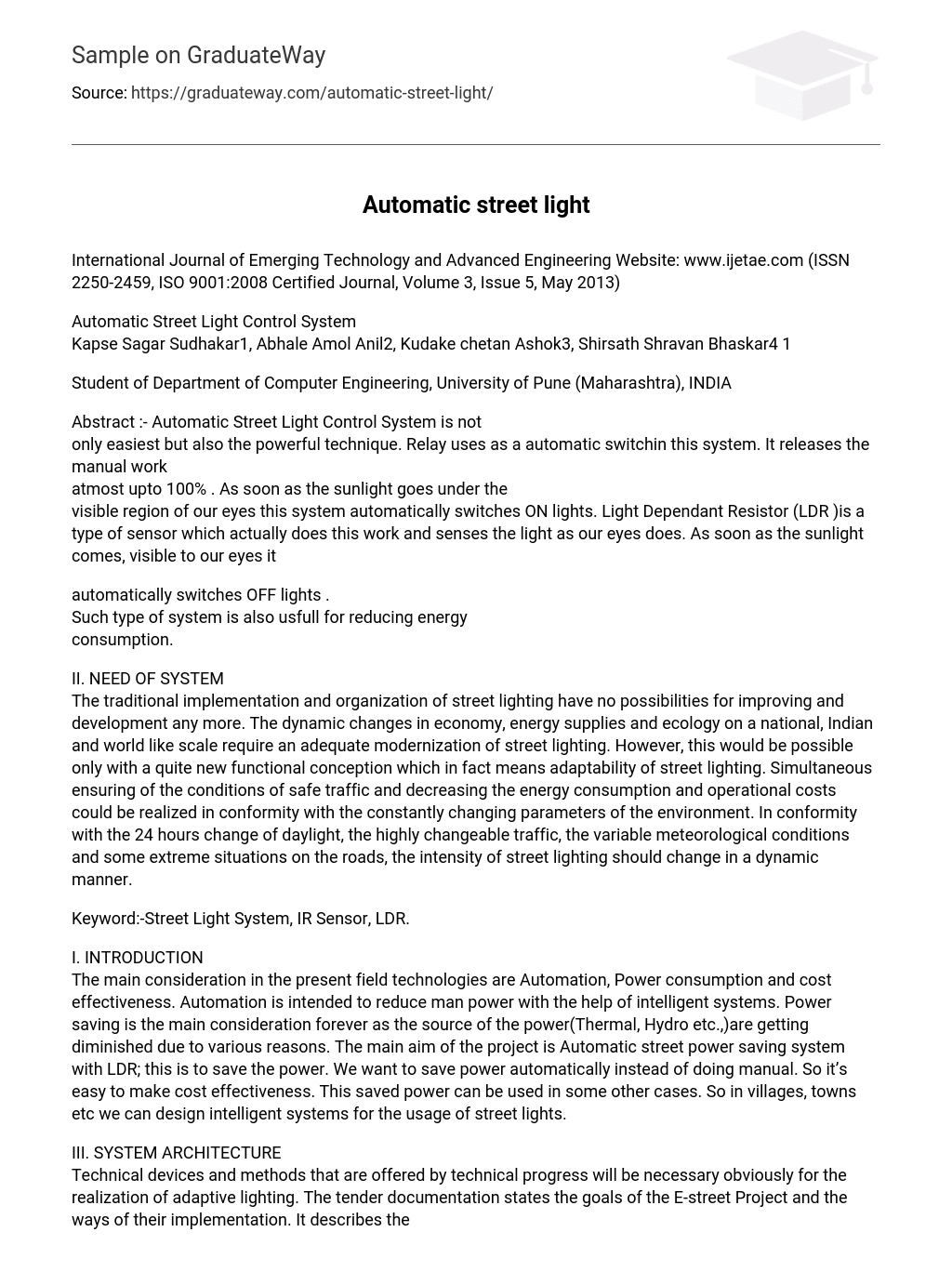NEED OF SYSTEM
The traditional implementation and organization of street lighting have no possibilities for improving and development any more. The dynamic changes in economy, energy supplies and ecology on a national, Indian and world like scale require an adequate modernization of street lighting. However, this would be possible only with a quite new functional conception which in fact means adaptability of street lighting.
Simultaneous ensuring of the conditions of safe traffic and decreasing the energy consumption and operational costs could be realized in conformity with the constantly changing parameters of the environment. In conformity with the 24 hours change of daylight, the highly changeable traffic, the variable meteorological conditions and some extreme situations on the roads, the intensity of street lighting should change in a dynamic manner.
INTRODUCTION
The main consideration in the present field technologies are Automation, Power consumption and cost effectiveness. Automation is intended to reduce man power with the help of intelligent systems. Power saving is the main consideration forever as the source of the power(Thermal, Hydro etc.,)are getting diminished due to various reasons. The main aim of the project is Automatic street power saving system with LDR; this is to save the power. We want to save power automatically instead of doing manual. So it’s easy to make cost effectiveness. This saved power can be used in some other cases. So in villages, towns etc we can design intelligent systems for the usage of street lights.
SYSTEM ARCHITECTURE
Technical devices and methods that are offered by technical progress will be necessary obviously for the realization of adaptive lighting. The tender documentation states the goals of the E-street Project and the ways of their implementation. It describes the system structure and the technical requirements towards its subsystems: roadside equipment, power system, local control system, central supervisory system and communication network. The content and project requirements for the implementation of Adaptive street lighting – project management, quality assurance and installation requirements – are given.
Future Scope
As we are measuring traffic density according to that we can control the traffic of the road and can avoid a traffic jam problem which implies avoidances of accidents.
Conclusion
The ASLCS (Automatic Street Light Control System) based Light intensity & traffic density, in the todays up growing countries will be more effective in case of cost, manpower and security as compare with today’s running complicated and complex light controlling systems. Automatic Street Light Controlling System puts up a very user friendly approach and could increase the power saving.
A. LDR input : When the light level is low the resistance of the LDR is high. This prevents current from flowing to the base of the transistors. Consequently the LED does not light.
However, when light shines onto the LDR its resistance falls and current flows into the base of the first transistor and then the second transistor. The preset resistor can be turned up or down to increase or decrease Resistance, in this way it can make the circuit more or less sensitive, LDR send response to 89S52 microcontroller.
REFERENCES
- Caponetto, R., Dongola, G., Fortuna, L., Riscica, N. and Zufacchi, D. (2008), “Power consumption reduction in a remote controlled street lighting system”, International Symposium on Power Electronics, Electrical Drives, Automation and Motion (SPEEDAM 2008), Ischia, une, pp. 428-33.
- Costa, M.A.D., Costa, G.H., dos Santos, A.S., Schuch, L. and Pinheiro, J.R. (2009), “A high efficiency autonomous street lighting system based on solar energy and LEDs”, Brazilian Power Electronics Conference (COBEP 2009), Bonito, 27 September-1 October, pp. 265-73.
- Farmer C. M. 2005. Relationships of Frontal Offset Crash Test Results to Real-World Driver Fatality Rates. Traffic Injury Prevention, 6, 31-37.
- R. Swift, C. Martin, L. Swette, A. LaConti and N. Kackley, “Studies on a Wearable, Electronic, Transdermal Alcohol Sensor,” 16 Alcohol. Clin. Exp. Res. 721 (July/Aug. 1992) http://pdf1.alldatasheet.com/datasheet-pdf/view/56224/





